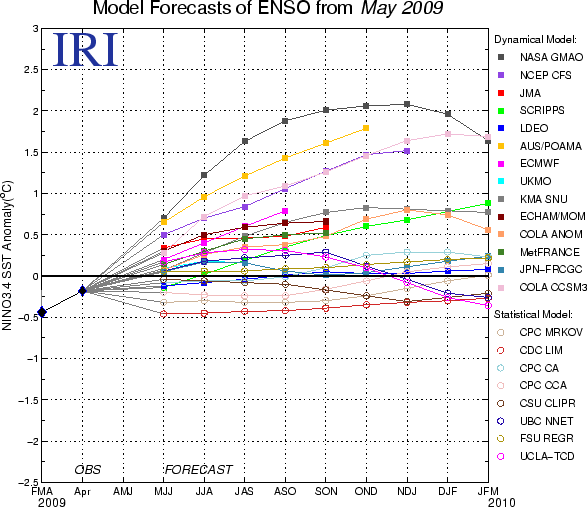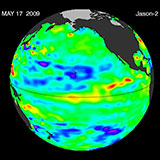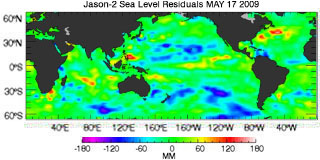Neutral Conditions Persist, But El Niño Trend Favorable
Sea Surface Temperatures (SSTs) and Mixed Layer Conditions:
ENSO-neutral conditions persisted across the equatorial Pacific Ocean during May. However, sea surface temperatures (SST) increased for a fifth consecutive month. The SST anomalies of all four Niño regions experienced warming in May (relative to April) and above-average temperatures extended across the equatorial Pacific Ocean by the end of the month.
For the most recent equatorial Pacific Ocean surface temperatures, please visit NOAA's Tropical Atmosphere Ocean (TAO) project and for weekly or monthly Niño region average SST and anomaly values, visit Climate Prediction Center's Atmospheric and SST Index values page.
Subsurface oceanic heat content anomalies continued to increase in May in response to a large area of above-average temperatures near thermocline depth. These surface and subsurface oceanic anomalies typically precede the development of El Niño.
A fifth consecutive month of three-month running means at or below the Oceanic Niño Index (ONI) La Niña conditions threshold (-0.5°C [-0.9°F]) was not met as the latest three-month (March-April-May) SST anomaly running mean of -0.1°C (-0.2°F) fell well within the neutral range. (NOTE: For NOAA's official ENSO classification scheme, please see NOAA's El Niño/La Niña Index Definition). Five consecutive values at or below this threshold constitutes a La Niña episode.
Current observations, recent trends, and the dynamic computer models indicate that conditions are favorable for a transition from ENSO-neutral to El Niño conditions by the end of August.
Equatorial Zonal Winds (U-Component Winds) and Sea-Level Topography:
Trade winds were weaker than normal over much of the tropical Pacific from late April to late May. During May, lower-level equatorial winds returned to near-average near the Date Line after enhanced low-level winds persisted in the region since early 2007. Collectively, the recent oceanic and atmospheric anomalies are consistent with ENSO-neutral conditions, but also reflect a potential trend towards El Niño.
Pacific sea levels measured by the NASA/JPL Jason satellite reflected ENSO-neutral conditions across the tropical Pacific Ocean in May. Much of the equatorial Pacific was near normal during the month.
Outgoing Longwave Radiation (OLR):
Outgoing Longwave Radiation (OLR) values decreased for the fifth consecutive month, from +1.0 W/m2 in April to +0.8 W/m2 in May. The map below on the left shows the spatial pattern of global OLR (in W/m2) measured by satellite during May. The lack of convection along the Equator near the Date Line has persisted since the development of the cold event in late May 2007.
The monthly OLR anomaly for May marked the 28th consecutive month that the OLR index had a positive monthly value. Persistently high positive OLR indices are typical of the mature phase of a La Niña episode, while negative values indicate the presence of increased convection and warm phase conditions.
Southern Oscillation Index (SOI):
The Southern Oscillation Index (SOI) was -0.4 for the month of May (down from +0.7 in April)—only the second negative value since June 2008 and third negative value since August 2007.
Additional Links
- ENSO Monitoring
- NOAA El Niño / La Niña Index Definition
- NOAA's Pacific Marine Environmental Laboratory (PMEL):
- NOAA's Climate Prediction Center (CPC):
- NOAA's Physical Science Laboratory
- NASA/JPL Ocean Surface Topography from Space
- Australian Bureau of Meteorology (BoM) Climate Driver Update
- IRI - International Research Institute
 NOAA's National Centers for Environmental Information
NOAA's National Centers for Environmental Information












